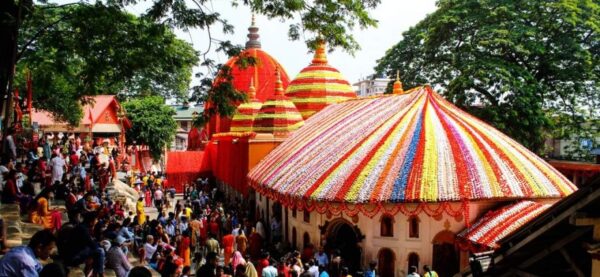History of Maa Kamakhya Temple
The origins of Maa Kamakhya Temple date back to ancient times and are deeply rooted in the Tantric Traditions of Sanatan Dharma. The earliest references to Maa Kamakhya can be traced to the Kalikapurana, which describes the temple as the most sacred seat of Maa Shakti.
The temple was initially built by the Koch King Naranarayan in the 16th century after being rediscovered in ruins. It is said that earlier structures may have existed as early as the 8th century under the rule of the Mlechchha Dynasty. The temple has since undergone several reconstructions, blending Ahom and Kamarupa Architectural Styles.
The main sanctum, known as the Garbhagriha, enshrines a Natural Rock Formation representing Maa Kamakhya’s Yoni, continuously bathed by an underground spring. Unlike conventional temples with idols, here Maa Herself manifests as the Divine Source of Creation.
Spiritual Significance
Maa Kamakhya is worshiped as the Goddess of Desire, Fertility, and Power. Devotees believe that the Temple is a place where the Union of Shiva and Shakti is eternally celebrated. The annual Ambubachi Mela, held in June, marks the time when Maa Kamakhya is believed to undergo Her annual period of seclusion, symbolizing the Sacred Feminine Cycle of Nature.
This festival attracts thousands of Sadhus, Tantrics, and Devotees from across the world who come to seek Maa’s Blessings. It is considered one of the most mystical and spiritually charged gatherings in India.
Architecture and Surroundings
The Temple complex consists of seven subsidiary shrines dedicated to different forms of Maa, such as Maa Tara, Maa Bhairavi, Maa Bagalamukhi, Maa Bhuvaneshwari, and others. The main dome of the Temple resembles a beehive-shaped Shikhara, typical of Assamese architecture. The scenic Nilachal Hill offers a panoramic view of the mighty Brahmaputra River and the lush green landscape of Guwahati.
How to Reach Maa Kamakhya Temple
- By Air:
The nearest airport is Lokpriya Gopinath Bordoloi International Airport, located about 20 km from the Temple. Regular flights connect Guwahati with major Indian cities like Delhi, Kolkata, and Mumbai. - By Train:
Kamakhya Railway Station, situated just 6 km away, is one of the main stations in Guwahati. It is well-connected with express and superfast trains from all major cities in India. - By Road:
Guwahati is well connected by road through National Highway 27. Local taxis, auto-rickshaws, and buses are easily available to reach the Temple from any part of the city.

